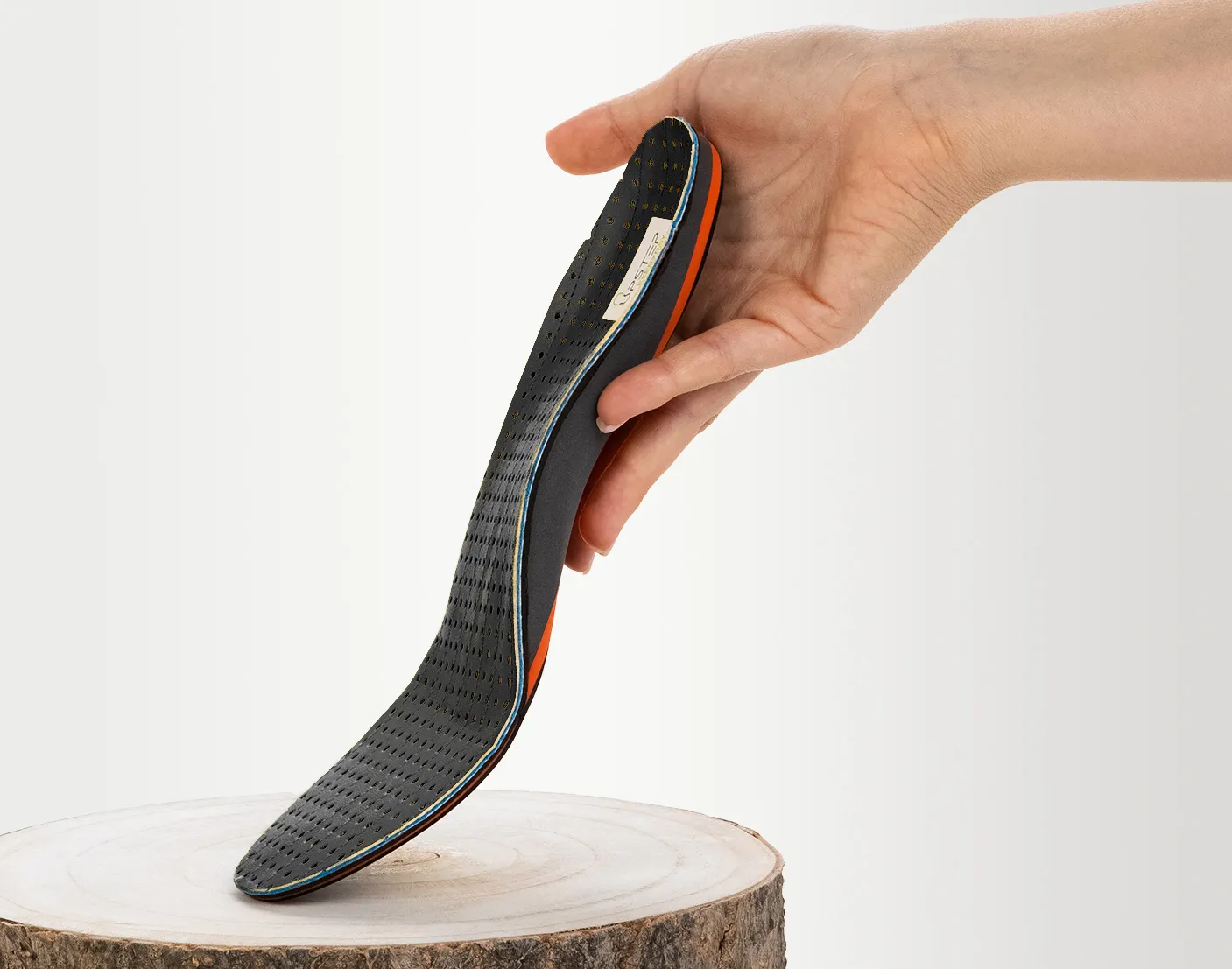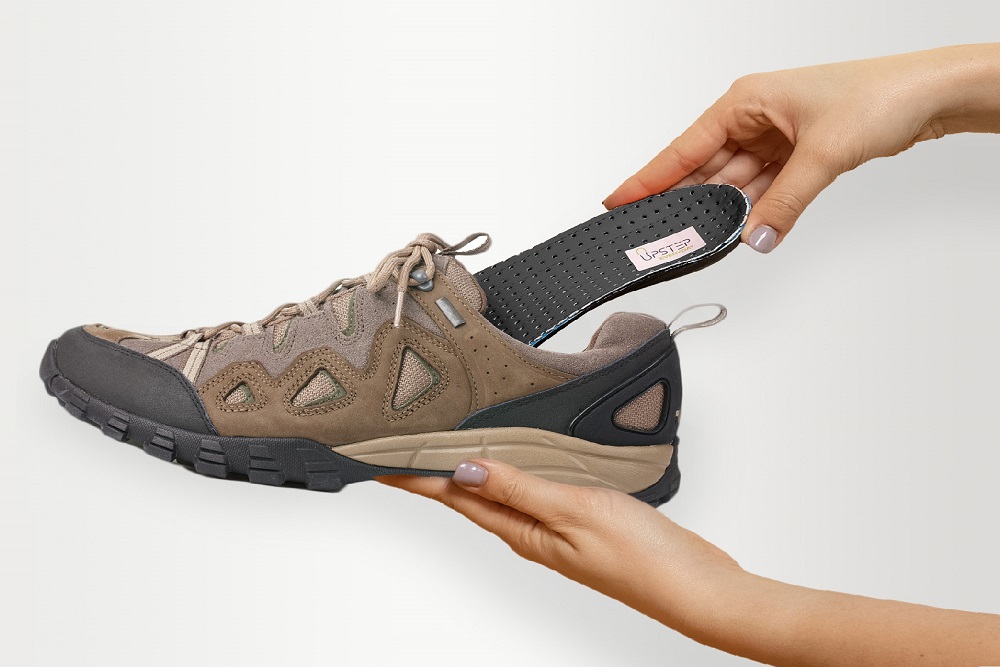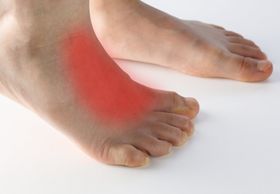How to Support Your High Arches & Why It Matters
Understand the impact of high arches on your feet and discover effective strategies for managing discomfort
Published August 19, 2024.

You've probably heard about flat feet and low arches, but did you know that having high arches can also cause problems? While not as common, high arches or pes cavus can lead to pain, discomfort, and even injuries.
Let's explore why arch support is crucial for people with high arches and discuss ways to find relief.
» High arches need specialized care. Get the support your feet deserve
Understanding High Arches
A foot with a high arch elevates the midfoot area more than usual, resulting in a larger gap between the ball of the foot and the heel when the foot is bearing weight.
Common causes include:
- Genetics: The most common cause is heredity. If one or both parents have high arches, their children are more likely to develop them as well.
- Neurological Conditions: Various neurological disorders can lead to high arches. These include Charcot-Marie-Tooth disease, cerebral palsy, spina bifida, and polio. Muscle imbalances or nerve issues can also cause the foot to develop an abnormally high arch.
- Structural Abnormalities: Sometimes, the bones in the foot are shaped or positioned to naturally create a higher arch.
- Muscular Disorders: Conditions that affect muscle tone and strength, like muscular dystrophy, can cause weakness in specific foot muscles, altering the structure over time.
- Trauma or Injury: In some cases, injuries to the foot or ankle can result in a high arch.
» Understand the anatomy of the foot through diagrams
While not everyone with high arches experiences problems, knowing the potential challenges is essential. These include
- Reduced Shock Absorption: The foot's natural shock-absorbing capacity is decreased, which can lead to stress on the ankles, knees, and hips. Over time, this may lead to conditions like plantar fasciitis or stress fractures.
- Instability and Balance: High arches can affect balance and stability, making the foot more susceptible to sprains and injuries.
- Pressure Point Issues: The increased pressure on the ball and heel of the foot can lead to pain, calluses, and other discomfort.
- Difficulty Finding Suitable Footwear: Many standard shoe designs don't accommodate high arches, making it difficult to find comfortable and supportive footwear.
- Long-term Impact: If left alone, high arches can affect posture, gait, and overall foot health.
» Find out how insoles can help correct gait imbalances
Why Support High Arches?
Adequate arch support is crucial for several reasons:
- Pressure Relief: High arches often concentrate pressure on specific foot areas, leading to discomfort and pain. Arch support helps distribute weight more evenly, reducing this pressure.
- Condition Prevention: Arch support can help prevent conditions like plantar fasciitis, metatarsalgia, and stress fractures by alleviating stress.
- Reduced Fall Risk: High arches can affect balance due to decreased contact with the ground. Arch support enhances stability, lowering the risk of falls and injuries.
- Enhanced Performance: Proper support is essential for athletes or individuals with active lifestyles for optimal performance and injury prevention.
- Correct Alignment: Arch support helps maintain proper foot alignment, preventing issues like overpronation or supination.
- Bodywide Benefits: Good foot alignment can positively impact posture, knee, and hip health.
» Read more about the different types of flat feet
How to Support High Arches
Orthotic Insoles
These inserts bridge the gap between the arch and the ground, providing support and stability. By evenly distributing pressure across the foot, they reduce strain on muscles and ligaments, alleviating pain and discomfort. They also address biomechanical issues like overpronation or supination.
Key benefits of orthotic insoles:
- Improved pressure distribution
- Enhanced foot alignment
- Increased shock absorption
- Reduced risk of stress-related foot conditions
» Check out the best orthotics for arch support
Supportive Footwear
Optimal shoes should feature solid heel counters for stability, arch support to distribute pressure evenly, and cushioning to absorb shock.
Look for shoes with removable insoles to accommodate custom orthotics and a wider toe box to prevent discomfort. Stability or motion-control shoes can help correct foot imbalances.
When shopping for shoes, try on several pairs and walk around in them. Pay attention to how the shoes feel, particularly in the arch area. Shoes that are too tight can exacerbate existing foot problems.
» Find the best insoles for treating plantar fasciitis pain in the legs
Arch Exercises
Strengthening the muscles that support the arch can help improve foot function and provide additional support for high arches. Here are some effective exercises:
- Toe Curls: Sit with your feet flat on the floor and place a small towel under your toes. Curl your toes to scrunch up the towel, hold for a few seconds, then release. Repeat 10–15 times.
- Arch Lifts: Stand barefoot and focus on lifting your arches while keeping your toes and heels on the ground. Hold for a few seconds, then relax. Repeat 10–15 times.
- Calf Raises: Stand on the edge of a step with your heels hanging off. Raise onto your toes, hold briefly, then lower back down. Repeat 15–20 times.
- Ankle Dorsiflexion: Sit with your legs extended. Loop a resistance band around your foot and pull it towards you while flexing it. Hold for a few seconds, then slowly release. Repeat 15–20 times.
Perform these exercises daily to strengthen the muscles supporting your arches. As you get stronger, you can increase the number of repetitions or add resistance.
» Explore the best exercises to strengthen the runner's knee
Stretching
Regular stretching helps maintain flexibility in the feet and lower legs. This can relieve tension and discomfort associated with high arches. Here are some beneficial stretches:
- Calf Stretch: Stand facing a wall with one foot forward and the other back. Keep both heels on the ground and lean forward until you feel a stretch in your back leg's calf. Hold for 30 seconds, then switch legs.
- Toe Stretch: Sit with one foot crossed over the opposite knee. Gently pull your toes back towards your shin until you feel a stretch along the bottom of your foot. Hold for 30 seconds, then switch feet.
- Achilles Tendon Stretch: Perform the downward dog yoga pose. Start on your hands and knees, then lift your hips while straightening your arms and legs. Press your heels towards the ground. Hold for 30 seconds.
- Plantar Fascia Stretch: Sit with one foot crossed over the opposite knee. Hold your toes and gently pull them back towards your shin. You should feel a stretch along the bottom of your foot. Hold for 30 seconds, then switch feet.
Perform these stretches daily after warming up your muscles with light activity. Always stretch gently and stop if you feel pain.
» Learn how to stretch the arch of your foot for pain relief
Taping or Bracing
Taping and bracing can provide temporary relief and support for high arches.
- Athletic taping involves applying specific tape patterns to support the arch and prevent excessive movement. While effective, it requires skill and may need frequent reapplication.
- Braces and supportive devices offer a more durable solution. From simple arch support sleeves to entire foot and ankle braces, they help maintain foot alignment and control motion.
For best results, consult a podiatrist or physical therapist who can demonstrate proper taping techniques or recommend bracing options. They can also ensure it's applied correctly and addresses your needs.
» Find out how to fix posture to prevent pain when walking
Massage Therapy
Massage helps relieve tension in foot muscles, improves flexibility, and enhances circulation. Here are some massage techniques that can be particularly helpful:
Effleurage: Use long, flowing strokes along the foot and lower leg. It helps improve circulation and relax muscles.
Deep Tissue Massage: Target deeper layers of muscle and connective tissue to alleviate chronic tension and knots. It can be particularly effective for specific areas of tightness or pain in the foot and lower leg.
Myofascial Release (MFR): Release tension in the fascia, the connective tissue surrounding muscles. It can help improve flexibility and reduce pain associated with high arches.
Trigger Point Therapy: Apply pressure to specific muscle points to release tension and alleviate pain.
You can self-massage using your hands or tools like massage balls or rollers. For best results, consider regular sessions with a professional massage therapist specializing in foot massage.
» Learn how to use massage to relieve plantar fasciitis
Your Feet Deserve the Best
Proper arch support is essential for individuals with high arches. By cushioning the foot, distributing weight evenly, and improving alignment, arch support can significantly alleviate pain, prevent injuries, and enhance overall foot health.
While various support options exist, custom orthotic insoles offer the most tailored solution. These personalized inserts provide exceptional comfort and support, addressing specific foot issues and promoting optimal foot function.
» Tired of high arch pain? Discover the relief of custom insoles











